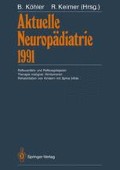Zusammenfassung
Die insulinähnlichen Wachstumsfaktoren (IGF-I und IGF-II) sind dem Insulin verwandte Polypeptide mit ähnlicher chemischer Struktur und Aminosäuresequenz. Die IGFs besitzen schwache insulinähnliche metabolische Wirkung und sind potente Mitogene für Zellen in vitro. In der Zirkulation liegen die IGFs an Transportproteine (IGF Bindungsproteine (BP)) gebunden vor. IGF-I gilt als wachstumshormonabhängiger wichtigster Mediator des postnatalen Wachstums. IGF-II wird für das Wachstum des Feten und Embryos, sowie für die Entwicklung des Zentralnervensystems (ZNS) mitverantwortlich gemacht [4, 7, 9]. Dabei scheinen die IGFs sowohl direkte Effekte auf das Wachstum von Neuronen und Gliazellen als auch auf die Differenzierung von Nervenzellen und Ganglienzellen zu haben [4–9]. Interessanterweise fand man relativ erhöhte Werte für die IGFs im Liqor von Patienten mit Hirntumoren [6], sowie einen erhöhten IGF-II-Spie-gel im Liquor von einem Kind mit Makrozephalie [8]. Um einen möglichen Zusammenhang zwischen den IGFs und der Entwicklung des Zentralnervensystems zu untersuchen, bestimmten wir die Konzentrationen von IGF-I, -II und dem wachstumshormonabhängigen IGF-Bindungsprotein, IGFBP-3, im Liquor von Kindern mit einer bekannten Störung der Gehirnentwicklung (Mikrozephalie) und im Liquor von Kindern, deren Gehirnentwicklung normal war.
Access this chapter
Tax calculation will be finalised at checkout
Purchases are for personal use only
Preview
Unable to display preview. Download preview PDF.
Literatur
Blum WF, Ranke MB, Bierich JR (1988) A specific radioimmunoassay for insulin-like growth factor II: the interference of IGF binding proteins can be blocked by excess IGF-I. Acta Endocrinol 118:374–380
Duffy KF, Pardridge WM, Rosenfeld RG (1988) Human blood-brain barrier insulin-like growth factor receptor. Metabolism 37:136–140
Hossenlopp P, Seurin D, Segovia-Quinson B, Hardouin S, Binoux M (1986) Analysis of serum insulin-like growth factor binding proteins using western blotting: use of the method of titration of the binding proteins and competitive binding studies. Anal Biochem 154:138–143
Latteman DF, King MG, Szot P, Baskin DG (1989) IGFs as regulatory peptides in the adult rat brain. In: LeRoith D, Raizada MK (eds) Molecular and cellular biology of IGFs and their receptors. Plenum, New York, pp 427–434
Pardridge WM (1986) Receptor-mediated peptide transport through the blood-brain barrier. Endocr Rev 7:314–330
Priseli P, Persson L, Boethuis J, Sara V (1987) Somatomedins in tumour cyst fluid, cerebrospinal fluid, and tumour cytosol in patients with glial tumours. Acta Neurochir 89:1–2
Rechler MM, Nissley SP (1990) Insulin like growth factors. In: Sporn MB, Roberts AB (eds) Peptide growth factors and their receptors. Springer, Berlin Heidelberg New York Tokyo, pp 263–367
Schönle EJ, Haselbacher GK, Briner J, Janzer RC, Gammeltoft S, Humbel R, Prader A (1986) Elevated concentration of IGF II in brain tissue from an infant with macrencephaly. J Pediatr 108:737–740
Shooter E (1991) Neurotrophic factors in the brain: where do IGFs fit? In: Spencer M (eds) Modern concepts of insulin-like growth factors. Elsevier, Holland, pp 297–308
Editor information
Editors and Affiliations
Rights and permissions
Copyright information
© 1992 Springer-Verlag Berlin Heidelberg
About this paper
Cite this paper
Schmitt, S. et al. (1992). Insulinähnliche Wachstumsfaktoren (IGF-I, -II) und ihr Bindungsprotein (IGFBP-3) im Liquor von Kindern: Mögliche Bedeutung für Entwicklung und Stoffwechsel des Zentralnervensystems. In: Köhler, B., Keimer, R. (eds) Aktuelle Neuropädiatrie 1991. Springer, Berlin, Heidelberg. https://doi.org/10.1007/978-3-642-77129-3_83
Download citation
DOI: https://doi.org/10.1007/978-3-642-77129-3_83
Publisher Name: Springer, Berlin, Heidelberg
Print ISBN: 978-3-642-77130-9
Online ISBN: 978-3-642-77129-3
eBook Packages: Springer Book Archive

